上海版牛津英语1B全册教案
牛津沪教版英语四年级上册Unit1-Unit12全册教案
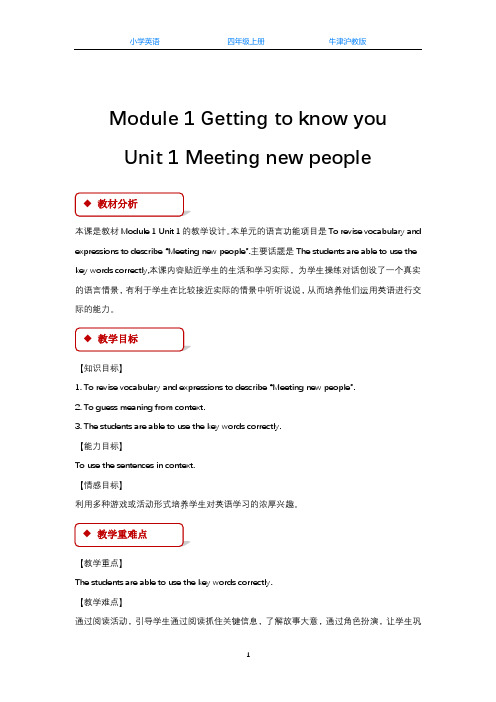
Module 1 Getting to know youUnit 1 Meeting new people本课是教材Module 1 Unit 1的教学设计。
本单元的语言功能项目是To revise vocabulary and expressions to describe “Meeting new people”.主要话题是The students are able to use the key words correctly,本课内容贴近学生的生活和学习实际,为学生操练对话创设了一个真实的语言情景,有利于学生在比较接近实际的情景中听听说说,从而培养他们运用英语进行交际的能力。
【知识目标】1. To revise vocabulary and expressions to describe “Meeting new people”.2. To guess meaning from context.3. The students are able to use the key words correctly.【能力目标】To use the sentences in context.【情感目标】利用多种游戏或活动形式培养学生对英语学习的浓厚兴趣。
【教学重点】The students are able to use the key words correctly.【教学难点】通过阅读活动,引导学生通过阅读抓住关键信息,了解故事大意,通过角色扮演,让学生巩固和运用本单元所学核心词汇和句型。
Tape recorder, Multimedia.Step 1. Warm up1. Listen and sayT: What do you know about “Meeting new people”?Look at the pictures on P2 and PPT. Talk about “Meeting new people”.To introduce them to the topic. And encourage them to talk about the topic.2. ListeningPlay the listening materials, stop when necessary. And then check the answers.To train the students’ ability of catching the information of the listening materials.Step 2. Presentation1. Look and learnLead them to read and explain the “Meeting new people”.e.g: This is your new classmate, his name is...2. Make and say(1) Learn the rules in P3.(2) Finish the exercise on P3 and group work to work out the usage method of the “Meeting new people”.(3) Walk around to exam the situation and check the answers for them.(4) List the method of for them.(5) To develop their interests and lead them to the conclusion.Step 3. Practice1. Say and actLet the students look PPT and act the scene.To make them get familiar with the details of the text and train their ability of saying and reading.2. Sing a song(1) Let the students look PPT and sing a song.(2) Let the students get the general idea of the text.3. Learn the letters(1) Learn the letters in P5.(2) List the letters for them.(3) To develop their interest and lead them to the conclusion.Step 4. Homework1. Dictation.2. Use the new words to make sentences on your own or check them in a dictionary.略。
牛津上海版(试用本)一年级上册英语Module 2 Unit 1 My abilities教案

《牛津英语》(上海版)1A Unit 1 My Abilities教学设计【教学内容】牛津英语1A第一单元My Abilities(我能做的事)【授课对象】一年级学生【教学设计】【设计理念】本课的话题是“我能做的事情”,授课对象是刚刚上小学三个月的一年级同学,结合学生的年龄特点,教师以深受小朋友喜欢的卡通Miffy小兔子一天的生活为本课的整体情景,学生在倾听与感受故事的过程中学习本课知识。
教师结合教学目标设计了丰富的课堂游戏活动,如帮助小兔子回家、摘单词、帮助小兔子闯关吃萝卜、读课文赢取萝卜“喂”兔子等……这些活动设计紧紧围绕本课知识与教学目标,旨在有趣的游戏活动中帮助一年级同学习得与巩固知识,培养参与意识与合作意识,面向全体给每个孩子运用所学语言参与游戏主动表达的机会。
【教学目标】知识与技能目标:(1)通过本课学习学生能够听懂会说,认读词汇:read ,sing, jump, draw;(2)学生会用I can …句型表达自己能做某事;过程与方法目标:(1)通过小组合作学习方式向学生提供应用英语与同伴交流、相互学习的机会,逐步培养合作意识与综合语言运用能力。
(2)学生通过参与课堂活动如:帮助小兔子回家、选择打开不同的礼物盒子、闯关等游戏,在学用结合的情境中锻炼观察能力、动手能力与探索意识。
(3)在学生运用自己所学知识帮助饥饿的小兔子赢取胡萝卜的环节,可帮助学生获得成功体验与感受,培养学生乐于与同伴、教师交流、合作学习和自主达成学习目标的意识。
情感、态度与价值观目标:(1)通关过本课学习,提升学生学习英语的兴趣与热情。
(2)通过有趣的情景与多种适合一年级学生能力和兴趣的教学活动,让学生体验到学习的快乐和成功的喜悦。
【教学重点】帮助学生认读单词 jump , sing, draw, read。
【教学难点】会用I can…表达自己能做的事。
【教学流程】歌曲热身师生合唱课前歌曲Can you swim?进行英语课前热身,通过欢快的英语歌曲将学生自然带入英语学习环境。
最新牛津英语1B-Unit-7-Happy-birthday-教材分析

牛津英语1B Unit 7 Happy birthday 教材解读一、学情分析一年级的小朋友具有“五好”心理:好奇、好动、好玩、好表现、好表扬。
授课老师要善于利用学生的这种心理,积极引导他们进入英语学习的殿堂。
从孩子的年龄特征与认知特征入手,逐步培养学生的学习兴趣、树立学习的自信心, 培养良好的英语学习习惯(听的习惯,说的习惯,读的习惯和写的习惯),打下良好的语音、语调基础,同时注重培养学生的观察、记忆、思维、想象和创新能力。
利用学生善“动”、注意力易分散的特征,创设出以听、说、唱、画、游、演、做等为主的活动,突出学生主体,让学生做学习的主人,让学生在在动作中学习、在游戏中学习,在情境中学习,努力做到教学生活化、情景化、游戏化。
二、课前教具、学具的准备教师准备好学生以前学过的有关食物的图片:coke cake sweet jelly milk 及水果图片:apple banana peach pear lemon orange. 以及多媒体课件。
还可准备一些食物作为奖品,例如一些糖果,果冻等作为奖品。
三、新旧知识间的衔接与过渡此单元涉及的食物类、水果类单词在以前学过,在1A中体现的有:apple orange pear lemon melon peach mooncake 及句型:what do you like to eat? I like to eat mooncakes. 在1Bunit1中体现的有:show me your present. 此单元达到的所学目标是掌握句型:what do you like? I like…. Happy birthday. Take your present. Open your present. Say “thank you”. 旧知的铺垫作用非常重要,对于新授词汇及句型都应该通过以旧引新的方式加以呈现,从而使得课堂教学水到渠成。
这样既可以降低新知的学习难度,又可实现语言知识的大面积滚动与综合积累。
最新上海牛津英语一年级下册课本1B
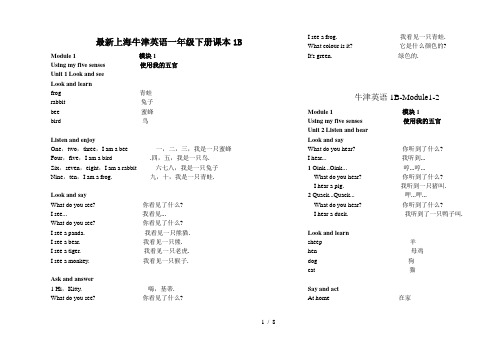
最新上海牛津英语一年级下册课本1BModule 1 模块1Using my five senses 使用我的五官Unit 1 Look and seeLook and learnfrog 青蛙rabbit 兔子bee 蜜蜂bird 鸟Listen and enjoyOne,two,three,I am a bee 一,二,三,我是一只蜜蜂Four,five,I am a bird .四,五,我是一只鸟.Six,seven,eight,I am a rabbit 六七八,我是一只兔子Nine,ten,I am a frog. 九,十,我是一只青蛙.Look and sayWhat do you see? 你看见了什么?I see... 我看见...What do you see? 你看见了什么?I see a panda. 我看见一只熊猫.I see a bear. 我看见一只熊.I see a tiger. 我看见一只老虎.I see a monkey. 我看见一只猴子.Ask and answer1 Hi,Kitty. 嗨,基蒂.What do you see? 你看见了什么?I see a frog. 我看见一只青蛙.What colour is it? 它是什么颜色的?It's green. 绿色的.牛津英语1B-Module1-2Module 1 模块1Using my five senses 使用我的五官Unit 2 Listen and hearLook and sayWhat do you hear? 你听到了什么?I hear... 我听到...1 Oink...Oink... 哼...哼...What do you hear? 你听到了什么?I hear a pig. 我听到一只猪叫.2 Quack...Quack... 呷...呷...What do you hear? 你听到了什么?I hear a duck. 我听到了一只鸭子叫.Look and learnsheep 羊hen 母鸡dog 狗cat 猫Say and actAt home 在家1 / 81 Oink...Oink... 哼...哼....What do you hear,Alice? 你听到了什么,艾丽丝?I hear a pig. 我听到一只猪叫.2 Oh,it's you,Danny. 哦,是你,丹尼.Ha!Ha! 哈!哈!Play a game1 Baa 咩咩声(羊的叫声)2 Miaow / Mew 猫的叫声/咪咪,喵喵3 Cluck 咯咯声(母鸡的叫声)4 Oink 呼噜声(猪的叫声)牛津英语1B-Module1-3Module 1 Using my five senses 模块1 使用我的五官Unit 3 Taste and smellLook and learnrice 米饭soup 汤egg 鸡蛋noodles 面条Look and sayTaste... 尝一尝...Smell... 闻一闻...Taste the noodles,Tom. 尝一尝面条,汤姆. Yummy.Yummy. 美味,美味.Smell the soup,Alice. 闻一闻这个汤,艾丽丝. It's nice. 真香.Say and actAt the restaurant 在饭店1 Can I help you? 你来点什么?Soup,please. 汤.2 Here you are. 给你.Thank you. 谢谢.3 Taste it,please. 请尝一尝.Hmm....Yummy.Yummy. 嗯...美味,美味.Play a game 做游戏1 Danny,stand up. 丹尼,起立.2 Alice,touch your nose. 艾丽丝,摸摸你的鼻子.3 Kitty,smell the flower. 凯帝,闻一闻花.Listen and enjoySmell the egg. 闻一闻鸡蛋.Smell the rice. 闻一闻米饭.Egg and rice,鸡蛋和米饭,Nice,nice,nice. 很好,很好,很好.Taste the soup. 尝一尝汤.Taste the noodles. 尝一尝面条.Soup and noodles. 汤和面条,Yummy,Yummy,Yummy. 美味,美味,美味.牛津英语1B-Module2-1Module 2 模块2My favourite things 我喜欢的东西Unit 1 Toys I likeLook and learnball 球doll 洋娃娃bicycle 自行车kite 风筝Look and say2 / 8I like... 我喜欢...I like balls. 我喜欢球.I like dolls. 我喜欢洋娃娃.I like kites. 我喜欢风筝.Play a gameI like the...Listen and enjoyI like the ball. 我喜欢球.I like the doll. 我喜欢洋娃娃.I like the ball and the doll. 我喜欢球和洋娃娃.I like the doll. 我喜欢洋娃娃.I like the ball. 我喜欢球.I like the doll and the ball. 我喜欢洋娃娃和球. Say and actAt the toy shop 在玩具店1 Can I help you? 你要买什么?I like the bicycle. 我喜欢自行车.I like the kite. 我喜欢风筝.2 Here you are. 给你们.Thank you. 谢谢你.3 I like the bicycle. 我喜欢我的自行车.It's super. 它太棒了.I like my kite.It's nice. 我喜欢我的风筝,它很不错Do a survey 做调查Toys 玩具I like…It's super…牛津英语1B-Module2-2Module 2 模块2My favourite things 我喜欢的东西Unit 2 Food I likeLook and learnjelly 果冻ice cream 冰淇淋sweet 糖biscuit 饼干Look and sayDo you like....? 你喜欢...吗?Yes./No. 是的./我不喜欢.1 Do you like sweets? 你喜欢糖吗?No. 不.2 Do you like jelly? 你喜欢果冻吗?Yes,I like jelly. 是的,我喜欢果冻.Say and actTea time 休息时间1 Do you like biscuits? 你们喜欢饼干吗?Yes. 是的2 One for you and one for me. 一个给你一个给我.3 One for you and one for me. 一个给你一个给我.4 One for you and one for me. 一个给你一个给我.5 Oh,Danny. 哦,丹尼.Sorry. 对不起I like biscuits very much. 我很喜欢吃饼干.Listen and enjoyI like ice cream. 我喜欢冰淇淋.3 / 8牛津英语1B-Module2-3 Module 2 模块2My favourite things 我喜欢的东西Unit 3 Drinks I likeSay and actA good girl 一个好女孩1 Drink some milk,Sam. 喝一些牛奶,萨姆. Woof...Woof... 汪...汪...2 Drink some water,Mum. 喝一些水,妈妈. Thank you. 谢谢.You are a good girl. 你真是个好孩子!Look and learncola 可乐juice 果汁milk 牛奶water 水Look and sayWhat do you like? 你喜欢什么?I like... 我喜欢...What do you like? 你喜欢什么?I like water. 我喜欢水.I like cola. 我喜欢可乐.Say and actAt Eddie's birthday party 在埃迪的生日会上1 Happy Birthday,Eddie! 生日快乐,埃迪! Thank you! 谢谢你们!2 Let's sing a birthday song. 让我们来唱首生日歌.3 What do you like? 你喜欢什么?I like cola. 我喜欢可乐.I like juice. 我喜欢果汁.I like... 我喜欢...Listen and enjoyHappy birthday to you 祝你生日快乐牛津英语1B-Module3-1Module 3 模块3Things around us 我们周围的事物Unit 1 SeasonsListen and enjoySpring is warm. 春天是温暖的.Summer is hot. 夏天是炎热的.Autumn is cool. 秋天是凉爽的.Winter is cold. 冬天是寒冷的.Spring,summer,春天,夏天,autumn,and winter. 秋天和冬天.Warm,hot,温暖,炎热,cool and cold. 凉爽和寒冷.Look and learnwarm 温暖的hot 炎热的spring 春天summer 夏天Play a gameSummer is... 夏天是...Hot! 炎热的!Red! 红色的!4 / 8Look and say.Spring is ... 春天是...Summer is... 夏天....1 Spring is green. 春天是绿色的.Spring is warm. 春天是温暖的.2 Summer is red. 夏天是红色的.Summer is hot. 夏天是炎热的.Say and actOutside 在外面1 In spring,I see flowers. 在春天,我可看见花朵.I smell flowers. 可闻一闻花朵.I sing a song. 可唱首歌.2 In summer,it's hot. 夏天,天气很炎热.I drink some juice. 我喝一些果汁.牛津英语1B-Module3-2 Module 3 模块3Things around us 我们周围的事物Unit 2 Weather 天气Look and learnsunny 晴朗的cloudy 多云的rainy 多雨的windy 有风的Look and sayHow is the weather? 天气怎么样?It's.... 天气是...1 How is the weather?天气怎么样?It's cloudy.多云.2 How is the weather?天气怎么样?It's...是...3 How is...?怎么样?Play a game 做游戏How is the weather? 天气怎么样?It's windy. 多风.No. 不对.It's cloudy. 是多云.Yes,it's cloudy. 对,是多云的.How is the weather? 天气怎么样?It's ...Do a survey 做调查The weather I like 我喜欢的天气Weather 天气Say and act 说一说,演一演Hot summer 炎热的夏天1 Good morning. 早上好.Good morning. 早上好.2 How is the weather? 天气怎么样?It's sunny. 很晴朗.It's hot. 很炎热.3 Let's go to the beach. 我们去海滩吧.OK. 好的.Listen and enjoy 听一听,玩一玩Rain,rain,go away 雨,雨,别下了牛津英语1B-Module3-3Module 3 模块3Things around us 我们周围的事物Unit 3 Clothes 衣服Look and learnT-shirt 体恤衫dress 连衣裙shorts 短裤blouse 上衣Look and say5 / 8I need... 我需要...1 Mum,look! 妈妈,看!I need a new T-shirt. 我需要一件新的体恤衫.2 Mum,I need a new dress. 妈妈,我需要一件新连衣裙Play a gameWhat do you need? 你需要什么?I need...Listen and enjoyShorts,a T-shirt,一条短裤,一件体恤衫a dress and a blouse,一条连衣裙和一件上衣,What do you need? 你需要什么?What do you need? 你需要什么?I need a blouse. 我需要一件上衣.I need a dress. 我需要一条连衣裙.I need a blouse and a dress.Say and actA nice blouse 一件漂亮的上衣1 I need a new blouse. 我需要一件新上衣.2 I don't like green,Mum. 妈妈,我不喜欢绿色.I like red. 妈妈.我喜欢红色.3 I like this blouse. 这喜欢这件上衣.It's nice. 它很不错.4 Thank you,Mum. 谢谢你,妈妈.牛津英语1B-Module4-1Module 4 Things we do 我们做的事Unit 1 ActivitiesListen and say1 What can you do? 你会做什么?I can sing. 我会唱歌.I can dance. 我会跳舞.I can draw. 我会画画.2 What can she do? 她会做什么?She can sing. 她会唱歌.Yes.she can sing. 是的,她会唱歌.Look and learnride 骑skip 跳play 玩fly 飞Listen and actPlay time 运动时间Play,play,play football. 踢,踢,踢足球.Skip,skip,skip a rope. 跳,跳,跳绳.Fly,fly,fly a kite. 放,放,放风筝.Ride,ride,ride a bicycle. 骑,骑,骑自行Play a game 玩游戏What can he/she do? 他/她会做什么?He/She can... 他/她会...Listen and enjoySkip my rope 跳绳6 / 8牛津英语1B-Module4-2Module 4 Things we do 我们做的事Unit 2 New Year's Day 新年Look and learngift 礼物card 贺卡firecracker 爆竹firework 焰火Listen and sayHappy New Year! 新年快乐!A gift for you,Kitty. 这是给你的礼物,基蒂.Thank you. 谢谢.Play a gameMake a New Year card 制作一张新年贺卡1 Draw. 画2 Write. 写3 Fold. 折叠4 Happy New Year,Miss Fang. 新年快乐,方老师.Thank you. 谢谢你.Listen and actShopping 购物1 I like the sweets. 我喜欢吃糖.2 I like the red dress. 我喜欢这条红色的连衣裙.3 I like the firecrackers. 我喜欢那种爆竹.4—Sweets for you,Mum and Dad. 把糖爸爸,妈妈,把送给你们.Happy New Year! 新年快乐!—Happy New Year! 新年快乐!Listen and enjoyHappy New Year 新年快乐!牛津英语1B-Module4-3Module 4 Things we do 我们做的事Unit 3 Story time 故事时间Look and learnboy 男孩wolf 狼farmer 农民narrator 讲解员Listen and enjoyA boy and a wolf 一个男孩和一只狼1 I'm the narrator. 我是讲解员.I'm the wolf. 我是狼.I'm the boy. 我是男孩.I'm the farmer. 我是农民.I'm the farmer. 我是农民.2 A boy and a wolf. 男孩和狼.3 A wolf! 有狼!Help!Help!.. 救命!救命!农民过来了.Where's the wolf? 狼在哪儿?Ha!Ha!No wolves . 哈哈!没有狼.7 / 85 A wolf!有狼!Help!Help!... 救命!救命!农民过来了.Where's the wolf? 狼在哪儿?Ha!Ha!No wolves. 哈哈!没有狼.You're a bad boy. 你是一个坏孩子.狼来了.A wolf!Help!Help!... 有狼!救命!救命....8 A poor boy. 可怜的孩子.9 Don't tell a lie! 不要说谎!农民过来了.The wolf runs away. 狼跑了.8 / 8。
一年级英语下册 1B Unit 6 Famer and fisherman教案 沪教牛津版
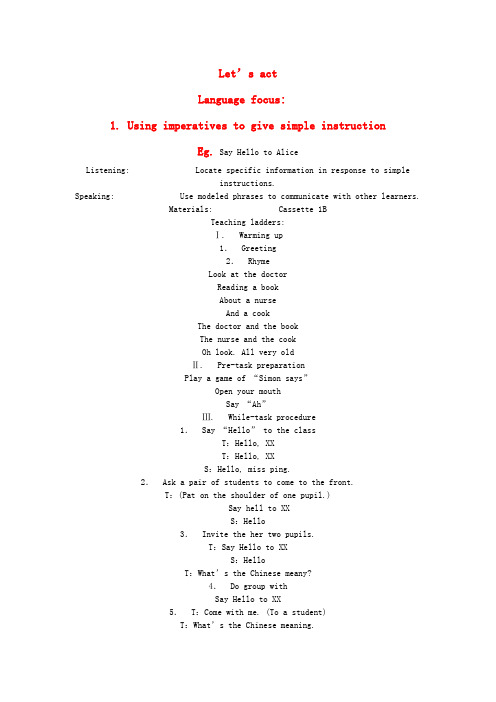
Let’s actLanguage focus:1. Using imperatives to give simple instructionEg. Say Hello to AliceListening: Locate specific information in response to simpleinstructions.Speaking: Use modeled phrases to communicate with other learners.Materials: Cassette 1BTeaching ladders:Ⅰ. Warming up1.Greeting2.RhymeLook at the doctorReading a bookAbout a nurseAnd a cookThe doctor and the bookThe nurse and the cookOh look. All very oldⅡ. Pre-task preparationPlay a game of “Simon says”Open your mouthSay “Ah”Ⅲ. While-task procedure1.Say “Hello” to the classT:Hello, XXT:Hello, XXS:Hello, miss ping.2.Ask a pair of students to come to the front.T:(Pat on the shoulder of one pupil.)Say hell to XXS:Hello3.Invite the her two pupils.T:Say Hello to XXS:HelloT:What’s the Chinese meany?4.Do group withSay Hello to XX5.T:Come with me. (To a student)T:What’s the Chinese meaning.6.T:Now pleas open your books.Listen & read after it.7.Listen it again.Have students repeat the senterces with the appropriate yes turesⅣ. Post-task activityPlay a match: Who is the qaickest to respond?Let’s talkLanguage focus:1. Using formulaic expressions to identify peopleEg. You are a farmer.2. Askky yes/no questions to identify people.particular thingEg. Are you a teacher?Listening: Locate specific information in response to simple questions. Speaking: Use modeled sentences to commicate with other learners. Materials: Wallchart 1BTeaching ladders:Ⅰ. Warming up1.Greeting2.TrainSay Hello to AliceCome with meⅡ. Pre-task preparation1.Revise the expression “Hello, I’m ……”T(go to a student)S:Hello, I’m a XXT:You are XX2.Invite pairs of students to come to the front and stand facing each other. T:You can use “You are XXYou are XX”Ⅲ. While-task procedure1.T:(hold up the “farmer” cards.)Farmer.(Get the students repeat)farmer2.Repeat the process with “fisherman”3.Press two students up as a farmer and a fisherman.T:(Point to the “farmer”)You are a fisherman.Yes or No.4.Repeat the precess with “fisherman”.5.T:(Look at the pictures)Farmer. You are a farmer.Fisherman.Your are a fisherman.6.T:(Point to myself)I am a teacher.I am an English teacher.T:(Point to a student)Are you a teacher?T:No, you are a student.7.T:Give the pointer to the studentsAre you a teacherT &S:Yes, I am.(Do it with other students again)8.T:Open your book P28Listen & FollowⅣ. Post-task activities1.Invite four students to stand in the front.Hold an object that tepresents a jobJave the rest of the class point to them one by one and say.You are a ……2.Group 1 act as a farmerGroup 2 act as a fishermanGroup 3 act as a teacherGroup 4 act as a doctor.(1) G 1:Are you a fisherman?G 2:Yes,Are you a teacher?G 3:Yes, Are you a doctor?G 4:Yes, Are you a farner?(2) G 1:Are you a fisherman?G 2:No, I’m a fisherman.Are you a fishman.3.Selsct graps to act out the dialogre.ConsolisationP19:Listen and hang only the correct pictures onto the books.Let’s learnLanguage focus:1. Using nouns to identify people.Eg. Farmer.2. Using adjectives to describe peopleeg. thinListening: locate specific information in response to simple questions. Speaking: 1. Use modellde phrases and sentences to communicate with other learners.2. Proumee words properlyMaterials: Word and Picture Cards 1bTeaching ladders:Ⅰ. Warming up1.Greeting2.TrainI am a ……(teacher, pupil)Ⅱ. Pre-task preparation1.Put up the picture and word cards for Unit 4&5 on the boaed.T:Who will came to the front?Put away the word.T:teacherS:(Put awey the word “teacher”) pupil, doctor, nu rse, cook, policeman, postman, driver, milkman, fireman2.Ask three students to act as a teacher, aformer and a fisherman.T:Who are you?S:You’re a teacher.(Point it one by one)3.Ask one sturent come to the front.T (teacher)The student act as a teacherS:Are you a teacher?S:Yes, I am.Ⅲ、 While-task properties1.Hold the picture cards for “farmer” “fisher enar” and “teacher” in the hanrds.T:XX, select are.Put it up on the board.Revise the word together.2.Write the words or the blackboard.Match the word & picture.3.Erase themT:(Pick out the correct word cards on the desk)4.Invit 2 pupil “for” “thin”T:FatT:thin5.T:fat, thin(With the hand gestures)6.T:Open your books. Turn to P29.Listen & Repeat.Ⅳ、 Post-task activityHhide any of the word cards at you backT:Wich word?Ⅴ、 Consolidationwork book page 20Listen & colourWork book page 21Tick the correct box.Let’s playLanguage focus:1.Using formulaic expressiong to identify peopleEg. You are a ……2.Using formulaic expressions to conform and dery things.Eg. Yes/NoSpeaking: 1. Open an interaction by eliciting a response.2. Maintain an interaction by using formulaic expressions to acknowlgdge, agree or disagree.Materials: Picture cards 1BMarks with pictures of people.Teaching ladders:Ⅰ. Pre-task preparation1.Pick up the picture and word cards for “famer, fisherman, teacher.Match it.2.Read the word one by one.Farmer, fisherman, teacher.Ⅱ. While-task procedure.1.Invite 6 students to arme to the front.T:Who will act as a doctor?nurse?policeman?postman?farmer?fisherman?teacher?T:Let’s point it & say.You are a ……2.Use a handkerchief to cover a volunteer’s eyesT:Come to the front & catch them & Guess “You one……”(1) Inivite a pupil of Group 1. 2. 3. 4(2) The rest of the class should tell him “Yes. No”3.Continve the game with other students.Let all the students have a chance to playⅢ、 Post-task activities1.Write the six adjective words “tall” “short” “fat” “thin” “young” and “old” on the board. Have students draw a person that fits each descriptin. 2.Play hide and seek after dass.Ⅳ、 CondolidationWork book page 21Can you find the word in the pnzzle?Colour the boxes.Let’s enjoyLanguage focus: Using adecties to decrile thingsEg. Thin pig.Fat pig.Speaking: Pronunce correctly words in connected speech by linking words together and using appropriate stress.Listening: Identify key words in an utterance by recognizing stress. Materials: Pictures , cards 1BTeaching ladders:Ⅰ. Warming up1.Greeting2.RhymeLooking at the doctor.Reading a book.About a nurse and a cook.The doctor and the book.The nurse and the cook.Oh, look.All very old.Ⅱ. Pre-task preparation1.Put the words cards for this armt on the board.T:Who takes care of animals?Who is it?2.Make enlarged photocopies of the two pigs from St udent’s. book page 31T:Which is fat?Which is thin?S:It is fat. It is thin.Ⅲ. While-task procedure1.T:Listen to the tape.Follow it.2.T:(Use hand gestures)Up, Dowm(Repeat for studeny to copy you)Up, Down.3.T:(Use body language)Thin, fat4.Show fingers for “One and two”Put hand on ehest for “I”Point to students for “you”Point to ceiling for “up”Point to floor for “down”Draw cirdes in the air for “round and round”5.Encourage students to read the rhyme.6.Let students do actions while reading out the rhyme7.Invite individual students to act out the rhyme to the class. Students vote for the best one.Ⅳ. Post-task activitieshave each group act out 1h rhyme.。
牛津英语1B全册教案(含单元分析)

教案学科:英语年级:一年任课教师:***学期:2012—2013学年度下学期学校:乐山镇中心小学校学生名册课程表“学科生命教育”课堂基本要素1、教师要树立“关爱生命、尊重人格、关注尊严、学生是学习的主体、学生是学习的主人”的理念,精心设计教学目标、教学内容、教学重点,深入挖掘教学内容中的生命教育因素,打造充满生命互动的课堂,使学生获得精神上的满足,使师生在相互作用中进行智慧的碰撞、情感的交融和心灵的沟通,使教学目标得到创造性的实现。
2、教师要用火热的激情调动与激发学生的学习热情和学习状态,通过恰当的教学方式和教学手段,积极构建温暖、和谐、平等的课堂氛围,以情融教,情景交融;以乐激教,快乐无限,使课堂焕发出生命的活力。
3、尊重学生的生命自由、生命差异,因材施教,尽量满足不同层次学生对知识的需求,引导学生正确理解和认识生命的意义。
4、倡导自主、合作、探究学习方式,爱护学生的好奇心、求知欲,努力为学生创造展示自己的机会,搭建展示的平台,鼓励学生在公众面前充分展示自己的学习成果和聪明才智。
5、在课堂教学过程中,让学生体验到自由、尊重、信任、友善、理解、关爱和亲情,受到激励、鞭策、感化和鼓舞,形成积极的人生态度和乐观的生命情感。
6、课堂上实施激励、明理式的评价,要以肯定、表扬、鼓励为主,让学生在“成功中体会快乐,在快乐中实现幸福”。
教学进度表(英语)课标要求听做:1、能根据听到的词语识别或指认图片或实物;2、能听懂课堂简短的指令并做出相应的反应;3、能根据指令做事情,如:指图片、涂颜色、画图、做动作、做手工等;4、能在图片和动作的提示下听懂简单的小故事并做出反应。
说唱:1、能根据录音模仿说英语;2、能相互致以简单的问候;3、能相互交流简单的个人信息,如:姓名、年龄等;4、能表达简单的情感和感觉,如:喜欢和不喜欢;5、能够根据表演猜测意思、说词语,6、能唱英语儿童歌曲15一20首,说歌谣15一20首;7、能根据图、文说出单词或短句。
高中英语unit1Bodylanguage-grammar教案牛津上海版S1A
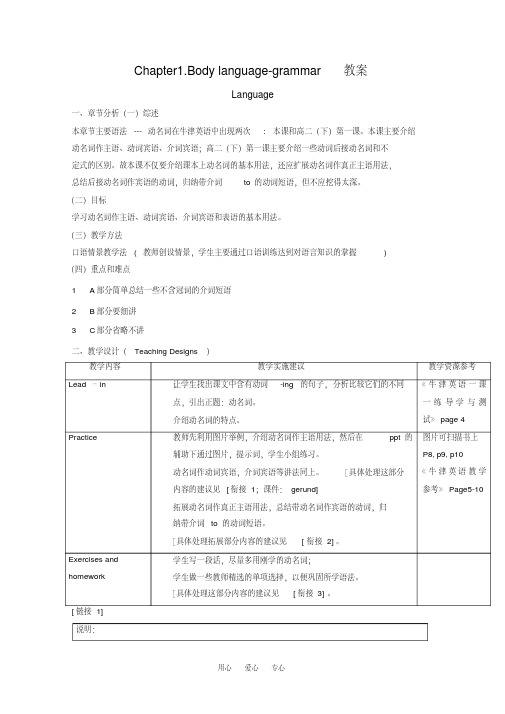
Chapter1.Body language-grammar教案Language一、章节分析(一)综述本章节主要语法---动名词在牛津英语中出现两次: 本课和高二(下)第一课。
本课主要介绍动名词作主语、动词宾语、介词宾语;高二(下)第一课主要介绍一些动词后接动名词和不定式的区别。
故本课不仅要介绍课本上动名词的基本用法,还应扩展动名词作真正主语用法,总结后接动名词作宾语的动词,归纳带介词to的动词短语,但不应挖得太深。
(二)目标学习动名词作主语、动词宾语、介词宾语和表语的基本用法。
(三)教学方法口语情景教学法( 教师创设情景,学生主要通过口语训练达到对语言知识的掌握)(四)重点和难点1A部分简单总结一些不含冠词的介词短语2B部分要细讲3C部分省略不讲二、教学设计(Teaching Designs)教学内容教学实施建议教学资源参考Lead –in 让学生找出课文中含有动词-ing的句子,分析比较它们的不同点,引出正题:动名词。
介绍动名词的特点。
《牛津英语一课一练导学与测试》page 4Practice 教师先利用图片举例,介绍动名词作主语用法,然后在ppt的辅助下通过图片,提示词,学生小组练习。
动名词作动词宾语,介词宾语等讲法同上。
[具体处理这部分内容的建议见[衔接1;课件:gerund]拓展动名词作真正主语用法,总结带动名词作宾语的动词,归纳带介词to的动词短语。
[具体处理拓展部分内容的建议见[衔接2]。
图片可扫描书上P8, p9, p10《牛津英语教学参考》Page5-10Exercises and homework学生写一段话,尽量多用刚学的动名词;学生做一些教师精选的单项选择,以便巩固所学语法。
[具体处理这部分内容的建议见[衔接3]。
[链接1] 说明:这是一份关于动名词的基础教学的教案与课件。
Step One lead-in1Ask students to find the sentences which have the form of v.+ing in the text .(possible answers):He gave an encouraging smile.Communicating is more than speaking and listening.She is holding her head up.2Explain the meaning and features of gerunds.Gerunds are –ing nouns. It is a kind of nouns. So in the above sentences, only“communicating, speaking, and listening” are gerunds. As a noun, gerunds canbe used as subject, verb object, preposition object, predicative and attributive. Step Two Presentation1Gerunds as subjects1)Example:T: What does shaking hands mean?S1: Shaking hands is a sign of friendship.S2: Shaking hands means that you are friendly.(动名词作主语时,位于动词用单数)2)PracticeStudents practise according to the example. They work in pairs. S1 makesquestions using the pictures and turning the verbs in brackets into –ing nouns. S2 chooses answers from the box.Shaking your fist is a sign of anger.Sighing is a sign of sadness.Yawning means that you are sleepy.Closing your eyes means that you are thinking.Whistling means that you are happy.Scratching your head means that you are thinking.Bowing is a sign of respect.(补充讲解句型It is (was) no use/good doing something.)2Gerund as verb objects1)Example:T: I didn’t know you could swim.S: Didn’t you? I love/ like swimming.T: So do I. I really enjoy swimming.I don’t. I hate / dislike swimming.I prefer walking.2)Practice:Students work in pairs to make similar dialogues about the pictures. Followthe example.3)Tell students some other verbs which have such usages.admit, appreciate, avoid, be worth, complete, finish, deny, delay, postpone,escape, practice, suggest, miss, allow, permit, forbid, consider, imagine3Gerunds after prepositionsOn her first day at work, Debbie saw the things. She didn’t know what they werefor, so she asked Mr Yang.Work in pairs to complete their conversation. S2 should answer S1, using –ing nouns made from the verbs in the box along with “for”.1)Example:T: Excuse me, but what are these _keys_____ for?S: They’re _for____ __locking_____ the drawers of the desk.2)Practice:Students work in pairs to make similar dialogues about the pictures. Followthe example.S1: And this _______?S2: It’s _______ ________ letters.S1: What about these _______ ________?S2: They’re _______ ________ your paper together.S1: This ________. What’s it for?S2: It’s _______ _______ the dates on documents.S1: And these ________?S2: They’re _______ ________. They’re a present for your first day at work.( 补充总结含介词to的动词短语:be (get)used to, get down to, look forward to, lead to, pay attention to, be devoted to, object to例如:Let’s get down to talking about your future.I’m look forward to hearing from you.)(见课件:gerund)[链接2]说明:这是动名词的拓展部分,拓展了动名词句型、接动名词做宾语的一些动词、接动名1下列句型后用动名词1)It’s no use / good doing…2)There is no point (in) doing …3)It’s worth doing…4)…can’t help doing…〖典型例句〗1)It’s no use crying over the spilt milk.2)The place is well worth visiting again.3)There is no point cheating in the exam.4)We can’t help laughing at the joke.5)It’s no good copying others’ homework.2下列动词后常接动名词做宾语1)admit, appreciate, avoid2)complete, consider3)delay, deny4)endure/stand, enjoy, escape, excuse5)finish6)imagine7)keep8)mind, miss9)postpone, practice10)resist, risk11)suggest巧记这些动词的诀窍:继续坚持勿停止;盼望完成莫推迟错过成功会后悔;惯于冒险须放弃避免原谅不逃脱;忙于欣赏禁不住介意练习很值得;考虑建议末延迟想象无用已无益;记得做过勿忘记禁止使用不定式〖典型例句〗1)I enjoy reading books in bed though it is not a good habit.2)I can’t imagine going to any place without you.3)Would you mind opening the door for me?4)He suggests reading English every day.5)The bird missed being shot.6)He escaped being punished by running away.3下列动词短语种to为介词1)be (get)used to2)get down to3)look forward to4)pay attention to5)be devoted to6)object to7)lead to〖典型例句〗1)I used to get up late, bu t now I’m used to getting up early.2)After discussing with his deskmate, he got down to writing his composition.3)I’m looking forward to hearing from you.以下几点可以在以后单元里讲解:1)need/ want / require 句型2)love, like, hate 后接 to do 与doing 作宾语的区别3)stop, remember, regret, try, mean, go on, forget后接 to do 与doing 作宾语的区別4)allow, permit, consider, advise后接 to do 与doing 作宾语和宾补的区别5)动名词的时态和语态6)动名词的复合结构[链接3]说明:Ⅰ单选:1.Do keeping _____, will you?A. to tryB. tryC. having triedD. trying2. We are all looking forward ______ Mr. Smith next week.A. to seeB. of seeingC. at seeingD. to seeing3. He spent all his time ______ for the final examination.A. to prepareB. of preparingC. in preparingD. to preparing4. The boy is only five years old, but he is quite used _____ the telephone.A. to answerB. to answeringC. of answeringD. by answering5. ______soundly is better for your illness than taking medicine.A. To sleepB. SleepingC. SleepD. Having slept6. Sometimes when I look into the sky, I feel like ______ a trip somewhere.A. to makeB. makingC. makeD. to go for7. I consider _____ of every fish is a kind of murder.A. takingB. a takingC. the takingD. to take8. My grandfather is a rich man, but ______ money does not solve all his problems.A. hasB. to haveC. havingD. having had9. It is no good ______ him to see you off.A. to expectB. expectingC. of expectingD. for him to expect10.There is one more book worth ______.A. readB. of readingC. being readD. reading11.He liked ______ many questions at the press conference.A. being askedB. askingC. of askingD. ask12.We had no trouble ______ the path through the forest.A. to findB. for findingC. findingD. with findingII.用括号里的动词的正确形式填空:1. He insisted on _______(do )the work in some other way.2. The windows want / need / require to be cleaned. That is, they need / want / require_____ (clean).3. He practiced _______(play) the piano every day.4. She doesn’t mind ______( work ) overtime.5. It will mean ______( benefit ) your company and mine.6. Have you decided to put off ______( go ) to the seaside?7. Peter kept (on) ______ (ask) questions.8. It’s a waste of time ______( argue) about it.9. _____ ( talk ) is easier than doing.10. Have you finished _______ (do) your homework?III.翻译:1. ______(每天晨读一刻钟)is very important in learning English.2. It’s no use _______(叹气).3. Debbie enjoys _______(微笑着与客户交流).4. John has just given up ______(吸烟).5. I ______(一直盼望着访问)China again.6. He run off to avoid ______(看见)by his class teacher.7. This machine is for ______(切纸).8. This book is well worth ______(读).9. ______(挥动拳头)is a sign of anger.10. Mr. Yang suggested/advised ______ (看着顾客的眼睛)to make a good impression on him.IV.拓展题:1.---You were brave enough to raise objections at the meeting.---Well, now I regret _____that.A. to doB. to be doingC. to have doneD. having done2.The patient was warned _____ oily food after the operation.A. to eat notB. eating notC. not to eatD. not eating3.She looks forward every spring to _____ the flower-lined garden.A. visitB. paying a visitC. walk inD. walking in4.The little time we have together we try _____ wisely.A. spending itB. to spend itC. to spendD. spending that5.While shopping, people sometimes can’t help ______ into buying something they don’t really need.A. to persuadeB. persuading D. being persuaded D. be persuaded6.What worried the child most was ______ to visit his mother in the hospital.A. his not allowingB. his not being allowedC. his being not allowedD. having not been allowed7.Tony was very unhappy for _____ to the party.A. having not been invitedB. not having invitedC. having not invitedD. not having been invited8._____ to sunlight for too much t ime will do harm to one’s skin.A. ExposedB. Having exposedC. Being exposedD. After being exposed9.The discovery of new evidence led to _____.A. the thief having caughtB. catch the thiefC. the thief being caughtD. the thief to be caught10.One learns a language by making mistakes and _____ them.A. correctB. correctingC. correctsD. to correct11.---You should have thanked her before you left.---I meant _____, but when I was leaving I couldn’t find her anywhere.A. to doB. toC. doingD. doing12.In some parts of London, missing a bus means_____ for another hour.A. waitingB. to waitC. waitD. to be waiting13.---What’s made John so angry?---______ the tickets for the concert.A. LoseB. To loseC. Because of losingD. Losing14. The day we are looking forward to _______ at last.A. arrivingB. arriveC. arrived D. arrives15. Mr. Reed made up his mind to devote all he had to ____ some schools for poor children.A. set upB. setting upC. have set upD. having set up附答案:Ⅰ.单选:DDCBBBCCBDBCⅡ.用括号里的动词的正确形式填空:doing, cleaning, playing, working, benefiting,going, asking, arguing, Talking, doing Ⅲ.翻译:1.Reading for a quarter of an hour every morning2.sighingmunicating with customers with a smile4.smoking5.am looking forward to visiting6.being seen7.cutting up paper8.reading9.Shaking one’s fist10.looking at customers’ eyesⅣ.拓展题:DCDBD BDCCB BADCB。
上海版牛津英语1B全册教案(含单元分析)

教学进度表(英语)课标要求听做:1、能根据听到的词语识别或指认图片或实物;2、能听懂课堂简短的指令并做出相应的反应;3、能根据指令做事情,如:指图片、涂颜色、画图、做动作、做手工等;4、能在图片和动作的提示下听懂简单的小故事并做出反应。
说唱:1、能根据录音模仿说英语;2、能相互致以简单的问候;3、能相互交流简单的个人信息,如:姓名、年龄等;4、能表达简单的情感和感觉,如:喜欢和不喜欢;5、能够根据表演猜测意思、说词语,6、能唱英语儿童歌曲15一20首,说歌谣15一20首;7、能根据图、文说出单词或短句。
玩演:1、能用英语做游戏并在游戏中用英语进行简单的交际;2、能做简单的角色表演;3、能表演英文歌曲及简单的童话剧,如(小红帽)等。
读写:1、能看图识字;2、能在指认物体的前提下认读所学词语;3、能在图片的帮助下读懂简单的小故事;视听:1、能看懂语言简单的英语动画片或程度相当的教学节目;2、视听时间每学年不少于10小时(平均每周20一25分钟)。
牛津英语1B教材分析教材分析:1.本套教材注重听说训练,着重培养学习的语感和初步用英语进行简单日常交流的能力;并通过听、说、读、写、唱、游、演、画、做等活动激发学生的学习兴趣,帮助学习养成良好的学习习惯,形成有效的学习方法,发展自主学习的能力,为进一步学习打下基础。
2.按“话题--功能--结构--任务”相结合的原则编写,并力求使话题、功能、结构和任务四个方面在比较真实的情景中紧密联系,融为一体。
3.内容贴近学生的生活和学习实际,并配有大量生动活泼、富有情趣的插图,以利于学生比较接近于实际的情景中进行听说训练,也为教师组织教学活动提供方便。
本学期采用的教材为牛津英语(上海版)一年级第一学期1B.全册教材共有三个主题九个单元,分别为:Theme 1: SpringUnit 1: New YearUnit 2: Small animalsUnit 3: ColoursTheme 2: People who help usUnit 4: Postman and policemanUnit 5: Doctor and nurseUnit 6: Farmer and fishermanTheme 3: Food and drinkUnit 7: Birthday partyUnit 8: DinnerUnit 9: Revision教学目标:在这个学期中要求学生达到的也就是本学期的教学的总的目标是:1.要求学生很扎实的掌握好书本的各个知识点。
上海牛津版英语小学一年级1BM3U2(5)

Module 3 Things around usUnit 2 Weather (1)Ⅰ. Look and circle〈根据所给的单词,把正确的单词部分圈出来〉:1. weather2. rainy3. how4. the5. cloudy6. sunnyⅡ. Look and number〈看图,将单词的编号写在相应的图片下〉:1. rainy2. cloudy3. sunny4. windy ( ) ( ) ( ) ( ) w e a w e a t h e rr a i n r a i n y yh o m n o w h o w wt h a t h e r t h uc l o u c l o ud ys u n n s u n n y yⅢ. Read and match1. How is the weather? It’s sunny.●●A.2. How is the weather? It’s cloudy. ●●B.3. How is the weather? It’s windy. ●●C.4. How is the weather? It’s rainy. ●●D.5. How is the weather? It’s hot. ●●E.Ⅳ. Read and judge〈判断下列句子是否符合所给的情景,用☺或☹表示〉:1.想知道天气情况,你问:How is the weather?2.今天是下雨天,你说:It’s a sunny day.3.别人问你是否喜欢晴天,你说:Yes, I like rainy days.4.早晨,看见好朋友,你对好朋友说:Good afternoon..5.想邀请朋友去公园,你说:Let’s go to the park.Module 3 Things around usUnit 2 Weather (2)Ⅰ. Read and circle 〈读一读,圈出在意义上属于不同类的单词〉: 1. 2. 3. 4.Ⅱ. Read and tick 〈读句子,在相应的图片下打勾〉:1. It ’s summer. It ’s hot.A. ( )B. ( )2. Do you like windy days? No.A. ( )B. ( )3. It ’s summer. It ’s hot.A. ( )B. ( )4. Let ’s go to the beach.A. ( )B. ( )5. Do you like cloudy days? Yes.A. ( )B. ( ) A. how B. cowC. cat A. sunny B. weather C. rainy A. is B. are C. can A. beach B. peach C. appleⅢ. Look and choose〈看图,选出正确的单词,圈在字母代号上〉:1. 2. 3. 4. 5.A. rainy A. morning A. peach A. sunny A. AliceB. sunny B. afternoon B. beach B. cloudy B. KittyⅣ. Read and judge〈判断下列句子是否符合图意,用√或╳表示〉:1. 2.It’s a rainy day. ( ) Do you like cloudy days? Yes. ( ) 3. 4.Good afternoon. ( ) Do you like windy days? Yes. ( ) 5. 6.It’s spring. It’s warm. ( ) Is it a cloudy day? Yes. ( )Ⅴ. Read and judge〈阅读对话,按顺序用“1—4”给下列图片编号〉:1. Alice: Mum, how is the weather? Mum: It’s windy.2. Alice: Mum, is it sunny? Mum: No, it’s cloudy.3. Alice: Do you like sunny days? Mum: Yes, It’s nice.4. Alice: How is the weather? Mum: It’s rainy. Take an umbrella, please.Module 3 Things around usUnit 2 Weather (3)Ⅰ. Read and circle〈读一读,圈出正确的图片〉:1. 2.sunny summerA. B. A. B.3. 4.windy rainyA. B. A. B.5. 6.warm cloudyA. B. A. B.Ⅱ. Read and number〈读句子,在相应的图片下编号〉:1. --- How is the weather?2. --- How is the weather?--- It’s sunny. --- It’s cloudy.3. --- How is the weather?4. --- How is the weather?--- It’s rainy. --- It’s windy.Ⅲ. Look and circle〈看图,圈出适当的单词完成句子,圈在字母代号上〉:1. Let’s go to the ____________.A. peachB. beach2. How __________ the weather? It’s ho t.A. isB. are3. It’s a __________ day.A. rainyB. sunny4. Do you like windy days? ___________.A. YesB. No5. Is it a __________ day? Yes.A. cloudyB. windyⅣ. Read and choose〈读一读,选择正确的问句或答句,将字母代号写在前面的括号内〉:A. It’s summer. It’s hot.B. Yes, I like sunny days.C. I see the red sun.D. It’s sunny. It’s hot.E. I like hot days.( ) 1. --- How is the weather? --- _____________________( ) 2. --- Do you like sunny days? --- _____________________( ) 3. --- What do you like? --- _____________________( ) 4. --- What do you see? --- _____________________( ) 5. --- What season is it? --- _____________________Module 3 Things around usUnit 2 Weather (4)Ⅰ. Look and circle〈根据所给例词,在每行中找出一个,并把它圈出来〉:1. season2. weather3. how4. rain5. morningr a i m r a r a i nw e w e a t h e r rm o r n i n g i n gh o m n o w h o w hs e e s e a s o n sⅡ. Look and match〈看图,将下列图片与相应的句子连线〉:1.● ● A. Is it a rainy day? Yes.2.● ● B. How is the weather? It’s windy.3.● ● C. It’s summer, a hot day. ays.4.● ● D. Do you like sunny days? Yes.5.● ● E.No, I like cloudy day.Ⅲ. Read and tick〈看图,在符合要求的句子前打√〉:1. 2.( ) A. Do you like rainy days? Yes. ( ) A. How is the weather? It’s hot. ( ) B. Do you like rainy days? No. ( ) B. How is the weather? It’s cold.3. 4.( ) A. It’s a cloudy day. ( ) A. How is the weather? It’s sunny. ( ) B. It’s a windy day. ( ) B. How is the weather? It’s rainy.Ⅳ. Read and choose〈读一读,选择合适的应答句,将字母代号写在前面的括号内〉:( ) 1. What do you see? A. It’s hot. It’s big. I like the sun. ( ) 2. How is the sun? B. Yes, I eat ice cream.( ) 3. How is the weather? C. It’s windy. I like windy days.( ) 4. Do you like the sunny days? D. It’s yellow.( ) 5. What colour is the sun? E. I see the clouds in the sky.Ⅴ. Read and judge〈阅读对话,判断下列句子是否符合对话,用√或╳表示〉:A: Good morning. B: Good morning.A: How is the weather? B: It’s hot.A: Is it sunny? B: Yes, it is.A: Let’s go to the beach. B: OK.A: Look, the beach is nice. B: Yes, it’s very nice.( ) 1. It’s afternoon.( ) 2. It’s a hot day.( ) 3. We can see the sun.( ) 4. Is the beach nice? No.Module 3 Things around usUnit 2 Weather (5)Ⅰ. Read and number〈读一读,将下列图片的编号写在相应的句子前〉:How is the weath er? It’s su nny. How is the weather? It’s rainy.How is the weather? It’s windy. How is the weather? It’s cloudy.Ⅱ. Read and judge〈判断下列图片是否符合所给的句子,用√或╳表示〉:1. 2.Good afternoon. How is the weath er? It’s hot.( ) ( )3. 4.Do you like sunny days? Yes. Do you see the sun? No.( ) ( )Ⅲ. Read and choose〈情景选择,在符合情景的句子前打勾〉:1. 想要询问天气情况,你问:( ) A. What season is it? ( ) B. How is the weather?2. 告诉朋友,你喜欢有太阳的日子,你说:( ) A. I like sunny days. ( ) B. It’s a sunny day.3. 下午看见方老师,你说:( ) A. Good morning, Miss Fang. ( ) B. Good afternoon, Miss Fang.4. 想邀请同学一起去公园,你说:( ) A. Let’s go to the zoo. ( ) B. Let’s go to the park.5. 夏天真热啊,你说:( ) A. Summer is hot. ( ) B. Is summer hot?Ⅳ. Read and tick〈阅读短文,在图片下的空格内打勾〉:Hello, I am Kitty. I am a girl. I am tall. But Iam thin. I like spring. In spring, I smell theflower. The flowers are red and yellow. I likesunny days. I can see some bees in the park.But my brother〈弟弟〉likes windy days. Hecan fly the kites in the park.1. 2.A. ( )B. ( ) A. ( ) B. ( )3. 4.A. ( )B. ( ) A. ( ) B. ( )Module 3 Things around usUnit 2 Weather (1)Ⅰ. 1. weather 2. rainy 3. how 4. the 5. cloudy 6. sunny Ⅱ. 4213Ⅲ. 1. B 2. A 3. E 4. C 5. DⅣ. 1. ☺ 2. ☹ 3. ☹ 4. ☹ 5. ☺Module 3 Things around usUnit 2 Weather (2)Ⅰ. 1. A 2. B 3. C 4. AⅡ. 1. A 2. B 3. B 4. A 5. AⅢ. 1. A 2. A 3. B 4. A 5. BⅣ. 1. ╳ 2.╳ 3. √ 4. ╳ 5. ╳ 6. √Ⅴ. 4132Module 3 Things around usUnit 2 Weather (3)Ⅰ. 1. B 2. B 3. A 4. B 5. B 6. AⅡ. 3241Ⅲ. 1. B 2. A 3. A 4. B 5. AⅣ. 1. D 2. B 3. E 4. C 5. AModule 3 Things around usUnit 2 Weather (4)Ⅰ. 1. rain 2. weather 3. morning 4. how 5. seasonⅡ. 1. D 2. A 3. E 4. B 5. CⅢ. 1. B 2. A 3. B 4. AⅣ. 1. E 2. A 3. C 4. B 5. DⅤ. 1. ╳ 2. √ 3. √ 4. ╳Module 3 Things around usUnit 2 Weather (5)Ⅰ. 3124Ⅱ. 1. √ 2. ╳ 3. ╳ 4. √Ⅲ. 1. B 2. A 3. B 4. B 5. AⅣ. 1. A 2. B 3. A 4. A。
一年级上册英语教案1.Greetings牛津上海版

一年级上册英语教案1【主题】Greetings【话题】Period1:Greeting to my friendsPeriod2:Greeting to each other【教材及学情分析】Module1的主题是Greeting,其中Hello,Hi在学习预备期学生就差不多能够熟练运用,因此本单元中教学重点是学生要学会在不同的时刻段用G ood morning.Good afternoon.Goodbye来进行打招呼。
一年级刚入学的小朋友,依照其年龄特点,注意力集中时刻较短,因此在创设情境中,尽可能创设与学生生活贴近的情境,使他们产生共鸣。
而且一年级的小孩由于语言的积存量还不够,因此歌曲、儿歌等能使他们产生一定的爱好。
【单元教学目标】知识与技能:能听明白会说Hello./Hi.Good morning.Goodbye.Goodafternoon.等问候语,把握词汇morning和afternoon。
过程与方法:学会用Hello./Hi.Good morning.Goodbye.Good afternoon.来问候和交流。
情感、态度与价值观:通过对本课问候句子的学习,养成讲文明的良好适应。
并能够积极用这些问候语与新同学交朋友,增进新生之间的了解和友谊。
重点:1.能用I’m/I am向对方介绍自己的名字。
2.在具体的语境中能用Nice to see you.句型并回应对方的问候。
难点:能在真实的语境中进行问候与交流。
【分课时教学目标】Period1话题Period2话题语言知识能听明白会说Hello./Hi.Good morning.Good afternoon.问候语,初步识读morning和afternoon。
1.能听明白对方用I’m自我介绍,并用相应的句式回应。
2.了解问候语:Nice to see you.的功能,并能在相应的语境中进行问候。
3.能用Goodbye进行辞别。
语言技能与运用1.能区分morning,afternoon的发音,并在不同的语言情境中运用。
牛津上海版一年级上册小学英语教案(全册)

Module 1 Getting to know youUnit 1 Greetings教材分析教学目标本单元主要介绍见面问候语及回答,介绍礼貌用语及回答,如hello, hi, good morning, good afternoon和goodbye, I’m...为学生创设一个良好的英语学习环境,循序渐进地引导学生接受新知识,并学会使用。
通过角色朗读,为学生提供语言应用的机会,及时纠正学生在理解和掌握中的错误,达到巩固知识的目的。
给学生创造大胆开口说英语的机会,激发学习兴趣,巩固了知识。
教学目标1. To learn the new words: hello, hi, good morning, good afternoon和goodbye, I’m...2. To use formulaic expressions to greet people and bid farewell.3. To be polite of everyone.教学重难点To bring up pupils’ interests of learning English;课前准备Multimedia, sticks, flashcards .etc.教学过程Step1. Pre-task preparation1. Rhyme:Hello, hello, how are you.老师播放视频,让学生试着一起唱,并告知学生今天要学习如何打招呼。
2. Greetings:T: Hello! I’m teacher.S: Hi!设计目的:复习准备期所学的儿歌,营造融恰的英语气氛。
通过师生间的问候,增进师生友谊。
歌曲的引入即能培养欢乐课堂氛围,也为今天的学习奠定基础。
Step2. While-task procedure1. Learn: morningT: Good morning, children.Show the flashcard morning.告知学生morning的时间段,早上上学的时候相互之间打招呼说Good morning。
(完整版)上海版牛津英语1B全册教案,推荐文档

教学媒体 Recorder and workbook ,picture cards
教学效果 的反馈
课题
Module 1Using my five senses Play a game
教学目标
教学重点 和难点
Teaching Aims : 1. Asking wh-question to fine out what people see 2. Using formulaic expressions to indicate what people see 3. Using nouns to identify small animals. 4. Using indefinite articles to refer to particular animals.
课前学生 Listening to the recording of the text. 准备
教学流程 板书设计
Pre-task preparation
1.Warmer Ps: Sing the song: Greetings
2.Ask each student to make a mask of an animal. Ask them to put on their masks and make a dialogue with their partner.
教学重点 1. STRUCTURES: sheep hen dog cat …
和难点
2. FUNCTION: Using nouns to express animals’ noises.
高一英语Unit1Thephantomoftheoperareading教案牛津上海版S1B

Chapter1. The Phantom of the Opera -Reading一、章节分析(Reading section )(一)综述本章节讲述了一个故事:剧院魅影。
由于此剧在上海曾经演出过,因此学生们对这个主题应该是比较熟悉甚至热爱的。
因此,教师应充分利用学生的兴趣,将此名剧同课文相结合,来进行教授。
本课的任务有两个:1学生通过对课文的学习。
掌握一些核心词汇,例如:capture, kidnap, mask, magically等。
2通过学习课文,了解故事的写作方法,为writing部分做准备。
(二)阅读目标1知识目标学习课文中重点词、词组、句型和语法。
2能力目标通过阅读进一步了解歌剧的历史以及其他方面的知识。
3情感目标对文中的phantom的内心世界进行分析,判断文学作品中人物的善恶和性格的复杂矛盾性。
(三)教学方法采用任务型教学法组织教学,通过听说,讨论等具体活动,达到教学效果。
(四)重点和难点1词汇学习1)核心词汇belowobeyphantomrolekidnapaudiencereleaseburstmagicallyinjure2)拓展词汇operaangelexistcapture3)词组和短语a huge building, with seventeen floorsforce him to leave homemake a secret home for sbgain power overmust bebe crowded within the endbe filling with waterbe shocked atmake sb do4)句型学习1. In the middle of this lake was an island, and on that island, one hundred years ago, lived thePhantom2. …,he was so ugly that his own mother made him wear a mask,…教学设计(Teaching Designs)[链接1]说明:对课文背景知识的介绍。
沪教版牛津英语一年级下册课本1B
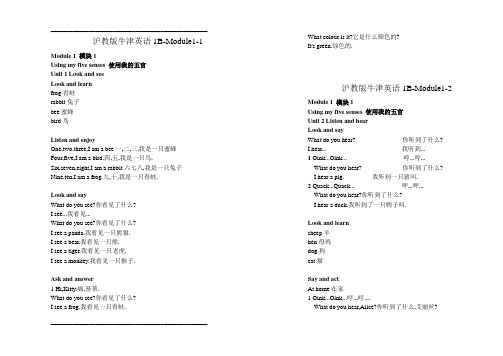
沪教版牛津英语1B-Module1-1Module 1 模块1Using my five senses 使用我的五官Unit 1 Look and seeLook and learnfrog青蛙rabbit兔子bee蜜蜂bird鸟Listen and enjoyOne,two,three,I am a bee一,二,三,我是一只蜜蜂Four,five,I am a bird.四,五,我是一只鸟.Six,seven,eight,I am a rabbit六七八,我是一只兔子Nine,ten,I am a frog.九,十,我是一只青蛙.Look and sayWhat do you see?你看见了什么?I see...我看见...What do you see?你看见了什么?I see a panda.我看见一只熊猫.I see a bear.我看见一只熊.I see a tiger.我看见一只老虎.I see a monkey.我看见一只猴子.Ask and answer1 Hi,Kitty.嗨,基蒂.What do you see?你看见了什么?I see a frog.我看见一只青蛙. What colour is it?它是什么颜色的?It's green.绿色的.沪教版牛津英语1B-Module1-2Module 1 模块1Using my five senses 使用我的五官Unit 2 Listen and hearLook and sayWhat do you hear? 你听到了什么?I hear... 我听到...1 Oink...Oink... 哼...哼...What do you hear? 你听到了什么?I hear a pig. 我听到一只猪叫.2 Quack...Quack... 呷...呷...What do you hear?你听到了什么?I hear a duck.我听到了一只鸭子叫.Look and learnsheep羊hen母鸡dog狗cat猫Say and actAt home在家1 Oink...Oink...哼...哼....What do you hear,Alice?你听到了什么,艾丽丝?__________________________________________________I hear a pig.我听到一只猪叫.2 Oh,it's you,Danny.哦,是你,丹尼.Ha!Ha!哈!哈!Play a game1 Baa咩咩声(羊的叫声)2 Miaow/ Mew猫的叫声/咪咪,喵喵3 Cluck 咯咯声(母鸡的叫声)4 Oink呼噜声(猪的叫声)牛津英语1B-Module1-3 Module 1 Using my five senses模块1使用我的五官Unit 3 Taste and smellLook and learnrice米饭soup汤egg鸡蛋noodles面条Look and sayTaste... 尝一尝...Smell...闻一闻...Taste the noodles,Tom. 尝一尝面条,汤姆. Yummy.Yummy. 美味,美味.Smell the soup,Alice. 闻一闻这个汤,艾丽丝. It's nice. 真香.Say and actAt the restaurant 在饭店1 Can I help you? 你来点什么? Soup,please. 汤.2 Here you are. 给你.Thank you. 谢谢.3 Taste it,please. 请尝一尝.Hmm....Yummy.Yummy. 嗯...美味,美味.Play a game 做游戏1 Danny,stand up. 丹尼,起立.2 Alice,touch your nose. 艾丽丝,摸摸你的鼻子.3 Kitty,smell the flower. 凯帝,闻一闻花. Listen and enjoySmell the egg. 闻一闻鸡蛋.Smell the rice. 闻一闻米饭.Egg and rice, 鸡蛋和米饭,Nice,nice,nice. 很好,很好,很好. Taste the soup. 尝一尝汤.Taste the noodles. 尝一尝面条.Soup and noodles. 汤和面条, Yummy,Yummy,Yummy. 美味,美味,美味.牛津英语1B-Module2-1Module 2 模块2My favourite things 我喜欢的东西Unit 1 Toys I likeLook and learnball 球doll 洋娃娃bicycle 自行车kite 风筝Look and sayI like... 我喜欢...I like balls. 我喜欢球.I like dolls. 我喜欢洋娃娃.I like kites. 我喜欢风筝.__________________________________________________Play a gameI like the...Listen and enjoyI like the ball. 我喜欢球.I like the doll. 我喜欢洋娃娃.I like the ball and the doll. 我喜欢球和洋娃娃.I like the doll. 我喜欢洋娃娃.I like the ball. 我喜欢球.I like the doll and the ball. 我喜欢洋娃娃和球. Say and actAt the toy shop 在玩具店1 Can I help you? 你要买什么?I like the bicycle. 我喜欢自行车.I like the kite. 我喜欢风筝.2 Here you are. 给你们.Thank you. 谢谢你.3 I like the bicycle. 我喜欢我的自行车. It's super. 它太棒了.I like my kite.It's nice. 我喜欢我的风筝,它很不错Do a survey 做调查Toys 玩具I like…It's super…牛津英语1B-Module2-2Module 2 模块2My favourite things 我喜欢的东西Unit 2 Food I likeLook and learnjelly 果冻ice cream冰淇淋sweet糖biscuit饼干Look and sayDo you like....?你喜欢...吗?Yes./No.是的./我不喜欢.1 Do you like sweets?你喜欢糖吗?No.不.2 Do you like jelly?你喜欢果冻吗?Yes,I like jelly.是的,我喜欢果冻.Say and actTea time 休息时间1 Do you like biscuits?你们喜欢饼干吗?Yes. 是的2 One for you and one for me.一个给你一个给我.3 One for you and one for me.一个给你一个给我.4 One for you and one for me.一个给你一个给我.5 Oh,Danny.哦,丹尼.Sorry. 对不起I like biscuits very much.我很喜欢吃饼干.Listen and enjoyI like ice cream.我喜欢冰淇淋.牛津英语1B-Module2-3 Module 2 模块2__________________________________________________My favourite things 我喜欢的东西Unit 3 Drinks I likeSay and actA good girl一个好女孩1 Drink some milk,Sam.喝一些牛奶,萨姆. Woof...Woof...汪...汪...2 Drink some water,Mum.喝一些水,妈妈. Thank you.谢谢.You are a good girl.你真是个好孩子!Look and learncola可乐juice果汁milk牛奶water水Look and sayWhat do you like?你喜欢什么?I like...我喜欢...What do you like?你喜欢什么?I like water.我喜欢水.I like cola.我喜欢可乐.Say and actAt Eddie's birthday party 在埃迪的生日会上1 Happy Birthday,Eddie!生日快乐,埃迪!Thank you!谢谢你们!2 Let's sing a birthday song.让我们来唱首生日歌.3 What do you like?你喜欢什么?I like cola.我喜欢可乐.I like juice.我喜欢果汁.I like...我喜欢...Listen and enjoyHappy birthday to you祝你生日快乐牛津英语1B-Module3-1 Module 3 模块3Things around us我们周围的事物Unit 1 SeasonsListen and enjoySpring is warm.春天是温暖的.Summer is hot.夏天是炎热的.Autumn is cool.秋天是凉爽的.Winter is cold.冬天是寒冷的.Spring,summer,春天,夏天,autumn,and winter.秋天和冬天.Warm,hot,温暖,炎热,cool and cold.凉爽和寒冷.Look and learnwarm温暖的hot炎热的spring春天summer夏天Play a gameSummer is...夏天是...Hot!炎热的!Red!红色的!Look and say.Spring is ...春天是...Summer is...夏天....1 Spring is green.春天是绿色的.Spring is warm.春天是温暖的.2 Summer is red.夏天是红色的.Summer is hot.夏天是炎热的.__________________________________________________Say and actOutside 在外面1 In spring,I see flowers.在春天,我可看见花朵.I smell flowers.可闻一闻花朵.I sing a song.可唱首歌.2 In summer,it's hot.夏天,天气很炎热.I drink some juice.我喝一些果汁.牛津英语1B-Module3-2 Module 3 模块3Things around us 我们周围的事物Unit 2 Weather天气Look and learnsunny晴朗的cloudy多云的rainy多雨的windy有风的Look and sayHow is the weather?天气怎么样?It's....天气是...1 How is the weather?天气怎么样?It's cloudy.多云.2 How is the weather?天气怎么样?It's...是...3 How is...?怎么样?Play a game 做游戏How is the weather?天气怎么样?It's windy.多风.No.不对.It's cloudy.是多云.Yes,it's cloudy.对,是多云的.How is the weather?天气怎么样?It's ...Do a survey 做调查The weather I like 我喜欢的天气Weather 天气Say and act 说一说,演一演Hot summer 炎热的夏天1 Good morning.早上好.Good morning.早上好.2 How is the weather?天气怎么样?It's sunny.很晴朗.It's hot.很炎热.3 Let's go to the beach.我们去海滩吧.OK.好的.Listen and enjoy 听一听,玩一玩Rain,rain,go away 雨,雨,别下了牛津英语1B-Module3-3Module 3 模块3Things around us 我们周围的事物Unit 3 Clothes 衣服Look and learnT-shirt体恤衫dress连衣裙shorts短裤blouse上衣Look and sayI need...我需要...1 Mum,look!妈妈,看!I need a new T-shirt.我需要一件新的体恤衫.2 Mum,I need a new dress.妈妈,我需要一件新连衣裙Play a gameWhat do you need?你需要什么?I need...__________________________________________________Listen and enjoyShorts,a T-shirt,一条短裤,一件体恤衫a dress and a blouse,一条连衣裙和一件上衣,What do you need?你需要什么?What do you need?你需要什么?I need a blouse.我需要一件上衣.I need a dress.我需要一条连衣裙.I need a blouse and a dress.Say and actA nice blouse一件漂亮的上衣1 I need a new blouse.我需要一件新上衣.2 I don't like green,Mum.妈妈,我不喜欢绿色.I like red.妈妈.我喜欢红色.3 I like this blouse.这喜欢这件上衣.It's nice.它很不错.4 Thank you,Mum.谢谢你,妈妈.牛津英语1B-Module4-1Module 4 Things we do 我们做的事Unit 1 ActivitiesListen and say1 What can you do?你会做什么?I can sing.我会唱歌.I can dance.我会跳舞.I can draw.我会画画.2 What can she do?她会做什么?She can sing.她会唱歌.Yes.she can sing.是的,她会唱歌.Look and learn ride骑skip跳play玩fly飞Listen and actPlay time 运动时间Play,play,play football.踢,踢,踢足球.Skip,skip,skip a rope.跳,跳,跳绳.Fly,fly,fly a kite.放,放,放风筝.Ride,ride,ride a bicycle.骑,骑,骑自行Play a game 玩游戏What can he/she do?他/她会做什么?He/She can... 他/她会...Listen and enjoySkip my rope 跳绳牛津英语1B-Module4-2Module 4 Things we do 我们做的事Unit 2 New Year's Day 新年Look and learngift礼物card贺卡firecracker爆竹firework焰火__________________________________________________Listen and sayHappy New Year!新年快乐!A gift for you,Kitty.这是给你的礼物,基蒂.Thank you.谢谢.Play a gameMake a New Year card 制作一张新年贺卡1 Draw.画2 Write.写3 Fold.折叠4 Happy New Year,Miss Fang.新年快乐,方老师.Thank you.谢谢你.Listen and actShopping 购物1 I like the sweets.我喜欢吃糖.2 I like the red dress.我喜欢这条红色的连衣裙.3 I like the firecrackers.我喜欢那种爆竹.4—Sweets for you,Mum and Dad. 把糖爸爸,妈妈,把送给你们。
最新上海版牛津英语二年级上册全册教案_教学设计
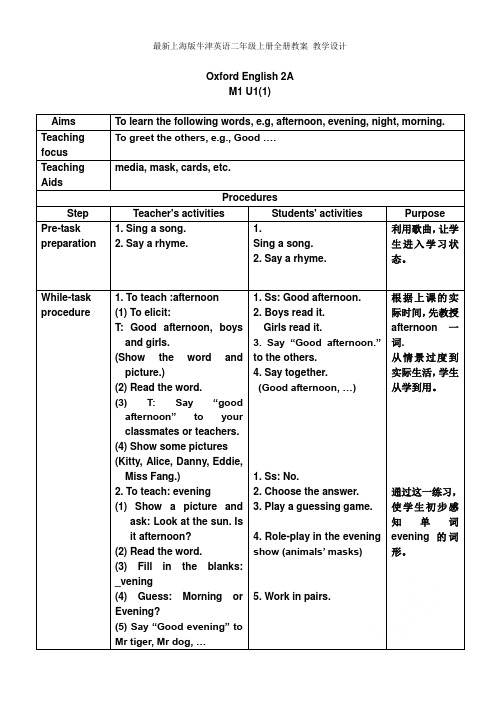
2. Do more exercises
3. Clap or repeat
4. Look and say
5. Look and choose
e.g. Good ____. (picture)
1. afternoon 2. morning
创设情景,给学 生特定的语境, 回归生活实际。
通过歌曲,活跃 课堂气氛的同 时巩固单词。
ask: Look at the sun. Is it afternoon? (2) Read the word. (3) Fill in the blanks: _vening (4) Guess: Morning or Evening? (5) Say “Good evening” to Mr tiger, Mr dog, …
让小朋友在看一 看、选一选、读一 读、演一演中加强 对本课的巩固。
板 1A M1U1 Greetings 书 How are you, ...? 设 I’m fine. Thank you. I’m fine. Thank you. And you? 计 I’m fine, too.
教学 反思
最新上海版牛津英语二年级上册全册教案_教学设计
学写字母注母大小写连线复习巩固同时引出小写字母联系生活让学生从单词中找字母熟悉巩固同时引出下面的绕口以星级来分层次阅读激发学生的挑战欲望让各个层次的学生都敢bigapplebigbag
最新上海版牛津英语二年级上册全册教案_教学设计
Oxford English 2A M1 U1(1)
Aims Teaching focus Teaching Aids
3. Quick response. 1. Learn: How are you, ...? I’m fine. Thank you. ① Follow the teacher and say.
牛津上海版一年级上册小学英语教案全册(1)
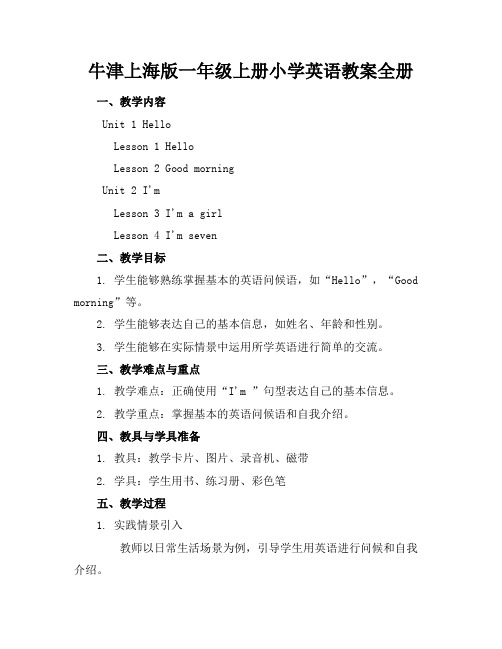
牛津上海版一年级上册小学英语教案全册一、教学内容Unit 1 HelloLesson 1 HelloLesson 2 Good morningUnit 2 I'mLesson 3 I'm a girlLesson 4 I'm seven二、教学目标1. 学生能够熟练掌握基本的英语问候语,如“Hello”,“Good morning”等。
2. 学生能够表达自己的基本信息,如姓名、年龄和性别。
3. 学生能够在实际情景中运用所学英语进行简单的交流。
三、教学难点与重点1. 教学难点:正确使用“I'm ”句型表达自己的基本信息。
2. 教学重点:掌握基本的英语问候语和自我介绍。
四、教具与学具准备1. 教具:教学卡片、图片、录音机、磁带2. 学具:学生用书、练习册、彩色笔五、教学过程1. 实践情景引入教师以日常生活场景为例,引导学生用英语进行问候和自我介绍。
学生进行角色扮演,练习问候和自我介绍。
2. 例题讲解教师讲解教材中的例题,如“Hello, I'm ”,“Good morning, I'm ”等。
学生跟随教师一起朗读,并模仿例题进行练习。
3. 随堂练习学生两人一组,互相问候和自我介绍。
教师随机抽取学生进行展示,并及时给予反馈。
4. 小组活动学生分成小组,进行“猜猜我是谁”的游戏,巩固所学知识。
六、板书设计1. 在黑板上写出本节课的重点词汇和句子。
2. 用不同颜色的粉笔标出教学难点和重点。
七、作业设计1. 作业题目:制作一张自己的名片,包括姓名、年龄、性别等信息,并用英语进行自我介绍。
2. 答案示例:Name: Zhang WeiAge: EightGender: BoySelfintroduction: Hello, I'm Zhang Wei. I'm eight years old. I'm a boy.八、课后反思及拓展延伸1. 教师反思:本节课学生的参与度较高,但部分学生在自我介绍时仍存在发音不准确的问题,需要在今后的教学中加强指导。
上海版牛津英语1B全册教案(含单元分析)
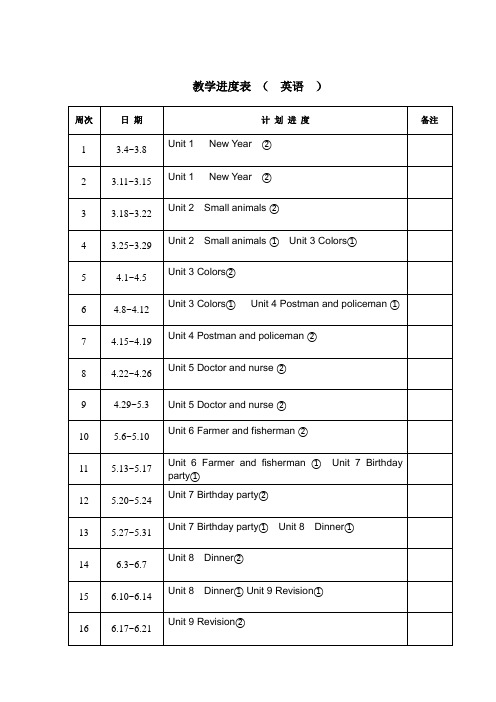
教学进度表(英语)课标要求听做:1、能根据听到的词语识别或指认图片或实物;2、能听懂课堂简短的指令并做出相应的反应;3、能根据指令做事情,如:指图片、涂颜色、画图、做动作、做手工等;4、能在图片和动作的提示下听懂简单的小故事并做出反应。
说唱:1、能根据录音模仿说英语;2、能相互致以简单的问候;3、能相互交流简单的个人信息,如:姓名、年龄等;4、能表达简单的情感和感觉,如:喜欢和不喜欢;5、能够根据表演猜测意思、说词语,6、能唱英语儿童歌曲15一20首,说歌谣15一20首;7、能根据图、文说出单词或短句。
玩演:1、能用英语做游戏并在游戏中用英语进行简单的交际;2、能做简单的角色表演;3、能表演英文歌曲及简单的童话剧,如(小红帽)等。
读写:1、能看图识字;2、能在指认物体的前提下认读所学词语;3、能在图片的帮助下读懂简单的小故事;视听:1、能看懂语言简单的英语动画片或程度相当的教学节目;2、视听时间每学年不少于10小时(平均每周20一25分钟)。
牛津英语1B教材分析教材分析:1.本套教材注重听说训练,着重培养学习的语感和初步用英语进行简单日常交流的能力;并通过听、说、读、写、唱、游、演、画、做等活动激发学生的学习兴趣,帮助学习养成良好的学习习惯,形成有效的学习方法,发展自主学习的能力,为进一步学习打下基础。
2.按“话题--功能--结构--任务”相结合的原则编写,并力求使话题、功能、结构和任务四个方面在比较真实的情景中紧密联系,融为一体。
3.内容贴近学生的生活和学习实际,并配有大量生动活泼、富有情趣的插图,以利于学生比较接近于实际的情景中进行听说训练,也为教师组织教学活动提供方便。
本学期采用的教材为牛津英语(上海版)一年级第一学期1B.全册教材共有三个主题九个单元,分别为:Theme 1: SpringUnit 1: New YearUnit 2: Small animalsUnit 3: ColoursTheme 2: People who help usUnit 4: Postman and policemanUnit 5: Doctor and nurseUnit 6: Farmer and fishermanTheme 3: Food and drinkUnit 7: Birthday partyUnit 8: DinnerUnit 9: Revision教学目标:在这个学期中要求学生达到的也就是本学期的教学的总的目标是:1.要求学生很扎实的掌握好书本的各个知识点。
牛津版小学英语四年级下册全册教案

牛津版小学英语四年级下册全册教案Unit 1 A new student第一课时一、教学内容: Unit 1 A: Read and say.二、教学目标:1、理解,掌握对话内容,用正确的语音语调朗读对话,初步表演对话。
2、正确运用日常交际用语Welcome to our school. Who’s that boy? I’m new here.3、能正确的听、说、读单词boy, woman, teacher, student, nurse三、教学重点: 能正确理解对话内容,朗读对话,初步表演对话四、教学难点: 流畅地朗读对话,并能在理解对话内容的基础上表演对话五、课前准备: 1、人物图片Mike ( student ), Miss Li( teacher ) Miss King ( nurse) Gao Shan (student ),人物头饰Ben2、单词卡片student, teacher, woman, teacher ,boy六、教学过程:(一)Free talk1、Hello, nice to meet you.2 、How are you ? / How are you this morning?3 、Are you happy today?4 、Welcome back to school.5、Good morning. Glad to meet you. Welcome back to school.(二)Presentation and practice: Ask and answer1、Good morning, boys and girls . Glad to meet you . Welcome back to school. 出示Welcome back to school. 理解并领读。
2、I have many pictures here .I like them very much. Do you like them? 出示所有的图片3、根据出示的照片复习单词boy , girl,man, woman4、Do you know these boys and girls? (出示Mike , Gao Shan, Nancy David, Helen 的照片):(1) Who‘s this boy? (Who‘s that boy?)He’s _______. He’s a student. (学习新单词student )(2) Who‘s this girl? (Who‘s that girl?)She‘s _________. She‘s a student.5、Do you know these men and women?( 出示Miss Li, Miss Gao Miss King , Mr Green, Mrs Green 的照片)(1)Who‘s this man? ( Who‘s that man?)He’s _________. He’s a teacher.(学习新单词teacher)(2) Who‘s this woman?(Who‘s that woman)She’s __________. She’s a nurse. (学习新单词nurse?)(三)Play a game (通过游戏复习并学习新的日常交际用语)1、闭上眼睛猜一猜:(1) A: Who‘s that ______?B: He‘s(She‘s) ________.A: He‘s (She‘s) a _________.B: You‘re right. ( You‘re wrong)(2) A: Excuse me. Are you _______?B:: No, I‘m not.A: Are you _________?B: Yes , I am.2、让一学生戴上Ben 的头饰让另一学生猜T: Who‘s this boy?S: He‘s ________.T: No, you‘re wrong.S: Are you ________?B: No, I‘m not.S: Are you _________?B: No, I‘m Ben.(四)Work in pairs1、Ben与老师对话:A: Hello, I‘m Ben. I‘m new here.B: Hello, I‘m Miss Li. Nice to meet you. Welcome to our school.学习:I’m new here.Welcome to our school.2、学生与Ben 对话(五)朗读课文1、听录音,跟读。
- 1、下载文档前请自行甄别文档内容的完整性,平台不提供额外的编辑、内容补充、找答案等附加服务。
- 2、"仅部分预览"的文档,不可在线预览部分如存在完整性等问题,可反馈申请退款(可完整预览的文档不适用该条件!)。
- 3、如文档侵犯您的权益,请联系客服反馈,我们会尽快为您处理(人工客服工作时间:9:00-18:30)。
课 前 学 生 Listening to the recording of the text. 准备
教学流程
I.
Pre-task preparation:
Warming up:
Have the Ss listen to the song about the farm animals.
the new words nose, sheep, …
1. Using the sentences: What do you see What colour is it 2. Using formulaic expression to introduce the animals
what
教学媒体 Recorder and workbook ,picture cards
Module 3 Things around us Unit 1 Seasons Unit 2 Weather Unit 3 Clothes
Module 4 Things we do Unit 1 Activities Unit 2 New Year's Day Unit 3 Story time
课题 教学目标
the students to listen to the dialogue.
the key pattern What do you see I see
…
T: What do you see ?
S;I see …
the students look at the pictures and practice in pairs.
a puppet.
4. Have the Ss to act all kinds of animals.
p4
What do you see I see …
What colour is it It
’s…
教学效果 的反馈
课题
Module1 Using my five senses
Unit 1 Listen and hear
Look and say
教学目标 the key words in context.
板书设计
While-task procedures 1. Use the paper cut-outs. Show the students some parts of
the small animals and ask them to guess what the animals are. The students can play this guessing game in groups. What is it It ’s a bee. 2. Ask the students to introduce each animal. It ’s a … It ’s … 3. Have the students look at the pictures and practice in pairs. What do you see I see … What colour is it It ’s… Post-task activities Let the student listen to the tape and repeat again and again The workbook Let students do the practice in the workbook. What do you see I see … What colour is it It ’s…
课 前 学 生 Listening to the recording of the text. 准备
教学流程 板书设计
Pre-task preparation
1. Warmer
Ps: Sing the song:
Greetings
each student to make a mask of an animal. Ask them to put
imperatives give simple instructions eg: I hear
…
教 学 重 点 1. STRUCTURES: sheep hen dog cat
…
和难点
2. FUNCTION: Using nouns to express animals
’ noises.
教学媒体 pictures
What do you see
I see.
What colour is it
It ’s…
5. Ask the students to play a game on book P5
What do you see
I see.. It ’s…
Post-task activity
Let ’s play
Ask the students to do Listen, colour and answer on workbook
上海版牛津 1B 全册教案 Module 1 Using my five senses Unit 1 Look and see Unit 2 Listen and hear Unit 3 Taste and smell
Module 2 My favourite things Unit 1 Toys I like Unit 2 Food I like Unit 3 Drinks I like
板书设计
frog rabbit bee bird I am a …
教学效果 的反馈
课题 教学目标
教学重点 和难点
Module 1 Using my five senses Unit 1 Look and see
Look and say Language Focus: Using formulaic expressions to learn the phrases; Language Skill: Listening: Understand the meanings of wh-questions Speaking: Ask wh-questions to find out what people see Use formulaic expressions to indicate what people see. Understand the meaning of wh-questions
eg. What do you see eg. I see a ….
教学媒体 Pictures, masks, Cassette 1A, Cassette player
课 前 学 生 Listening to the recording of the text. 准备
教学流程
Pre-task preparation the words of the animals. bird rabbit bee …. ; What do you see I see …. Are you a rabbit Yes No, I ’m a … the class into pairs. Ask tgen ti act as an animal and let the partner guess what animal it is. Are you a rabbit No, I ’m a …
eg. What do you see
3. Understand the key pattern
eg. I am a ….
with by
教学媒体 Pictures, masks, Cassette 1A, Cassette player
课 前 学 生 Listening to the recording of the text. 准备
on their masks and make a dialogue with their partner.
Hello. I am a bee. I am small.
Hi , I am a frog. I am green.
While-task procedure
the students the wall pictures .
II. While-task procedure:
1. Prompt the Ss to repeat after you.
Sheep hen dog cat …
2. Teach a new chant about the animals
I hear …
3. Ask the Ss to come to the front of the class and act as
教学重点 和难点
过 程 与 方 法 : modeled phrases to communicate
other students
modeled phrases to begin and maintain an
interaction by providing information in response
教学流程
Pre-task preparation 1. Warmer listen to the song:<Good morning> Greetings 2. Greetings. Good morning. Good afternoon. …… T: Ask pupils to answer the teacher
Module 1 Using my five senses Unit 1 Look and see
Look and learn 知识与技能: the new words in the context
eg. frog, rabbit, bee, bird wh-questions to find out what people see eg. What do you see formulaic expressions to indicate what people see eg. I dule 1Using my five senses Play a game
